With any marketing, it is important to ensure an advertiser’s message is directed to potential customers who can use a product or service. For Google advertisers, this translates into geographically restricting ads when needed. If a Campaign is not changed from the Google default, ads will be eligible to display for users across both the United States and Canada when a Google user’s search matches an advertiser’s keyword. Restricting an account geographically is important for e-commerce advertisers, and crucial for professional services advertisers since they typically have a geographically smaller pool of potential users.
When To Use Geographical Targeting?
Here are examples for both e-commerce and professional service retailers of when it would be necessary to create geographical targeting for a Google AdWords Campaign.
Example 1: An e-commerce advertiser ships their products to customers only within the continental United States. In this instance, the advertiser would want to implement Settings that restrict ads from displaying to users in Canada, Alaska and Hawaii.
Example 2: A professional service advertiser (such as a dentist) would like ads to be eligible for display only within a 7-mile radius of their office.
In both examples, it is critical to restrict where ads are eligible to display in order to avoid costs from users unable to become customers based on their location.
 Where ads for a Campaign are eligible to display is controlled within a Campaign’s Settings. The location setting can either be determined during the initial Campaign creation (see Chapter 4 – Proper Settings – The First Step of Successful Google Advertising for all Available Settings) or modified by accessing the Settings tab once a Campaign is active.
Where ads for a Campaign are eligible to display is controlled within a Campaign’s Settings. The location setting can either be determined during the initial Campaign creation (see Chapter 4 – Proper Settings – The First Step of Successful Google Advertising for all Available Settings) or modified by accessing the Settings tab once a Campaign is active.
Creating Proper Location Settings
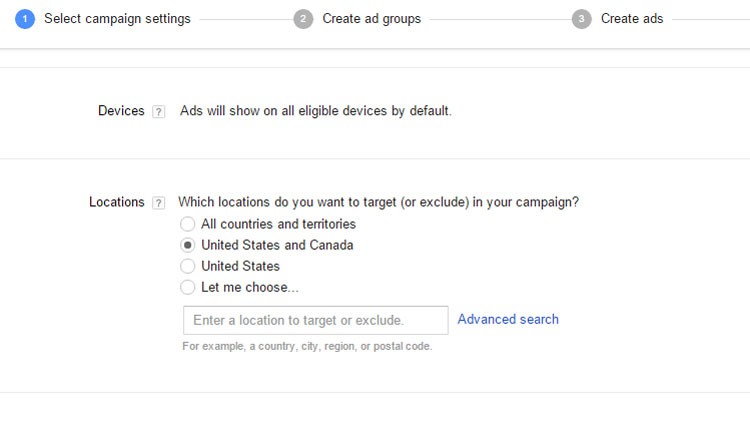 By default, Google has ads eligible to appear for all users within United States and Canada. This Setting will have ads eligible for display within this Campaign to users across the entire United States and all of Canada. Other options advertisers have within the Location settings include: All countries and territories (ads are eligible for display worldwide), United States (ads eligible for display in the US only) or Let me choose. Note, by utilizing the Let me choose Location setting advertisers can either add or exclude locations where ads will be eligible to appear.
By default, Google has ads eligible to appear for all users within United States and Canada. This Setting will have ads eligible for display within this Campaign to users across the entire United States and all of Canada. Other options advertisers have within the Location settings include: All countries and territories (ads are eligible for display worldwide), United States (ads eligible for display in the US only) or Let me choose. Note, by utilizing the Let me choose Location setting advertisers can either add or exclude locations where ads will be eligible to appear.
The Let me choose option is the option that both of the advertisers in our examples would need to select in order to implement desired settings.
E-commerce Advertiser’s Example
When the Advanced search link is selected, Google displays a location help window that includes Search, Radius targeting, Location groups and Bulk locations.
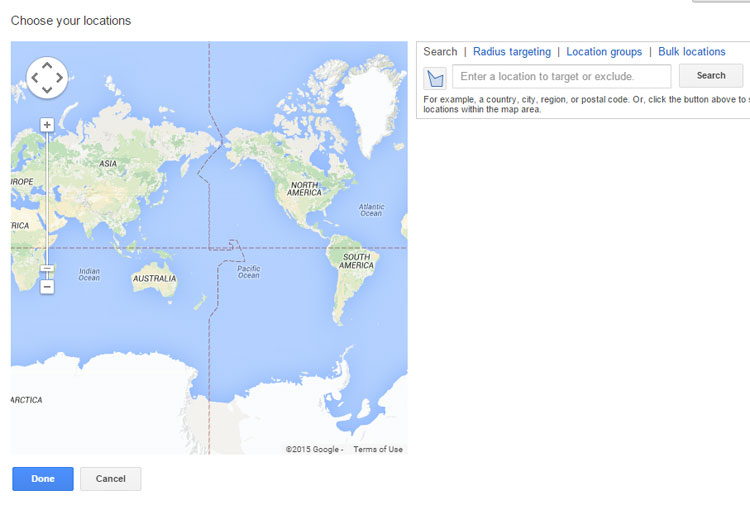 For our e-commerce advertiser, they would want to use the search box in order to add the United States and exclude Alaska and Hawaii.
For our e-commerce advertiser, they would want to use the search box in order to add the United States and exclude Alaska and Hawaii.
When the search box is populated, Google displays matching results for the search with available options to Add, Exclude or Nearby. Once the advertiser selects one of the options, they can continue to modify with multiple rules to match their criteria.
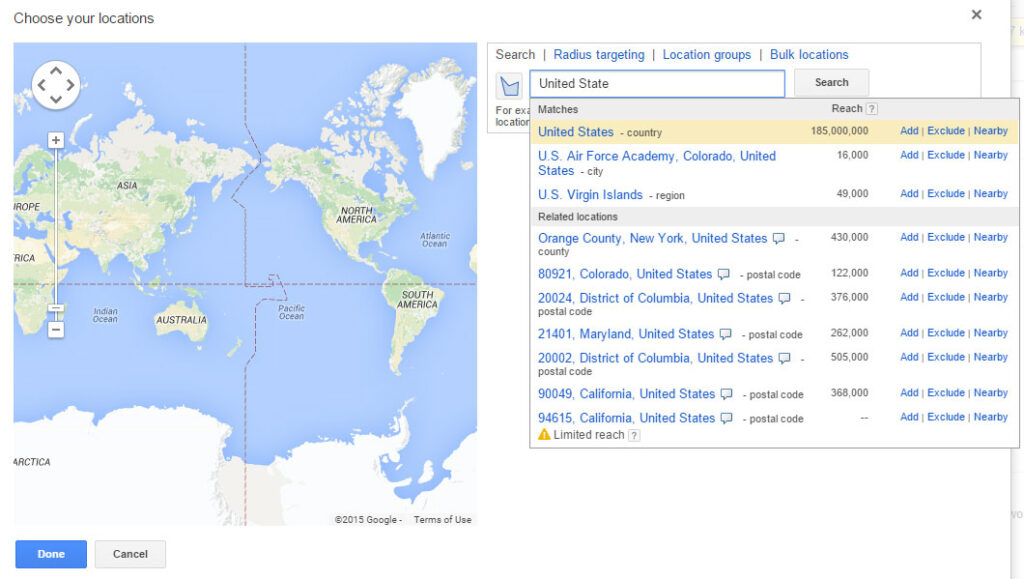 In this example, the advertiser would need to Add the United States and Exclude both Hawaii and Alaska. Once they are finished, clicking on the blue DONE button will return an advertiser to the Settings page now listing the saved options.
In this example, the advertiser would need to Add the United States and Exclude both Hawaii and Alaska. Once they are finished, clicking on the blue DONE button will return an advertiser to the Settings page now listing the saved options.
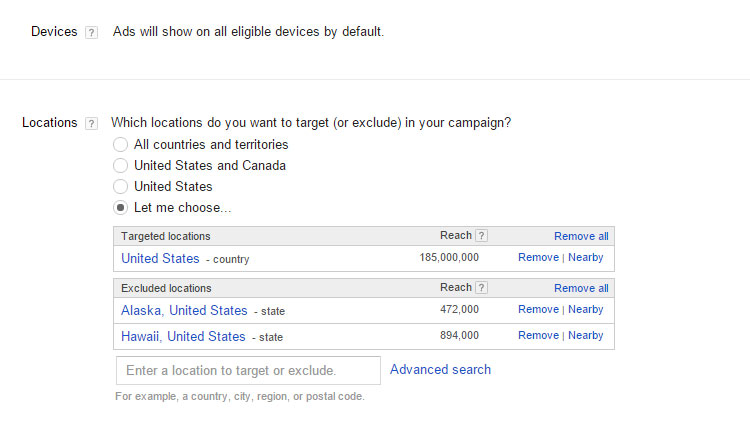 Locations are displayed as either Targeted locations (where ads are eligible for display) or Excluded locations (where ads are NOT eligible for display).
Locations are displayed as either Targeted locations (where ads are eligible for display) or Excluded locations (where ads are NOT eligible for display).
Professional Services Advertiser’s Example
Remember our professional service advertiser, the dentist? He wanted to only display ads within a 7- mile radius of his office.
In order for the professional service advertiser to format this desired setting, they would need to select the Advanced search link just like the e-commerce advertiser, but this time use the Radius targeting.
Within the Radius targeting, advertisers can base radius on the name of a place, address or coordinates and select the radius. In this example, I used zip code 91104 and selected within a 7 mile radius.
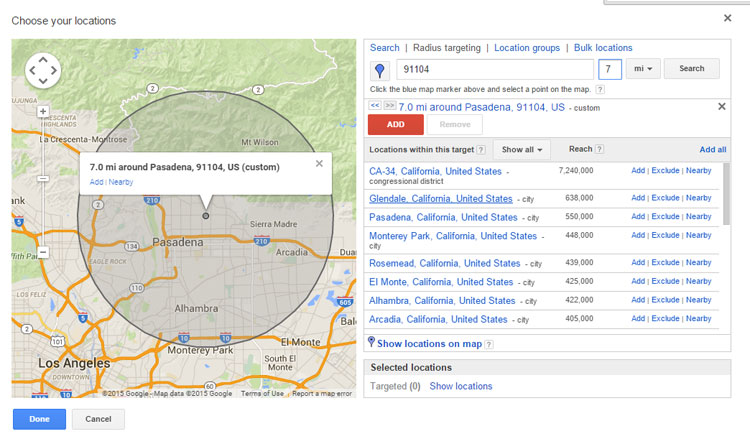 Google displays a map of the eligible location based on the data entered. Google also includes overlapping targeted cities, which can be used to Add, Exclude or use Nearby to further refine the geographic target.
Google displays a map of the eligible location based on the data entered. Google also includes overlapping targeted cities, which can be used to Add, Exclude or use Nearby to further refine the geographic target.
Other Location Targeting Options
We reviewed the use of the search and radius targeting in the two previous examples; however, Google also provides two lesser-used tools for geographical targeting – Location groups and Bulk locations.
Location groups – Location groups allow an advertiser to create Campaigns that display ads to customers based on types of places they visit, demographic location information or when they are in proximity to an advertiser’s location (works in conjunction with location extensions).
Bulk locations – Bulk locations allow advertisers to enter up to 1,000 locations and is used similar to radius targeting when advertisers have multiple locations to either target or exclude.
Changing Bids Based On Location
Once an advertiser has determined which location their ads are eligible for display and have enough data, it is possible to vary bids geographically.
In order for a Campaign to be eligible to change bids by location, a Campaign must enable the All types feature found within the Settings tab.
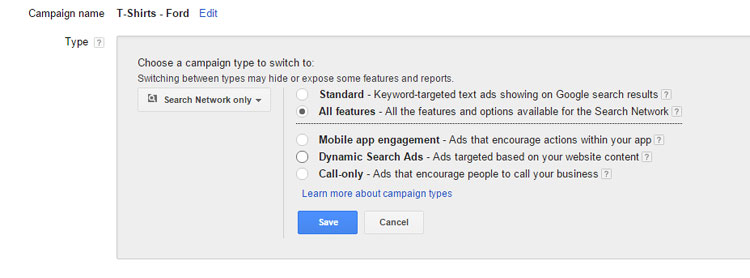 Once the All types feature is enabled a new Locations subtab will appear below the Settings tab.
Once the All types feature is enabled a new Locations subtab will appear below the Settings tab.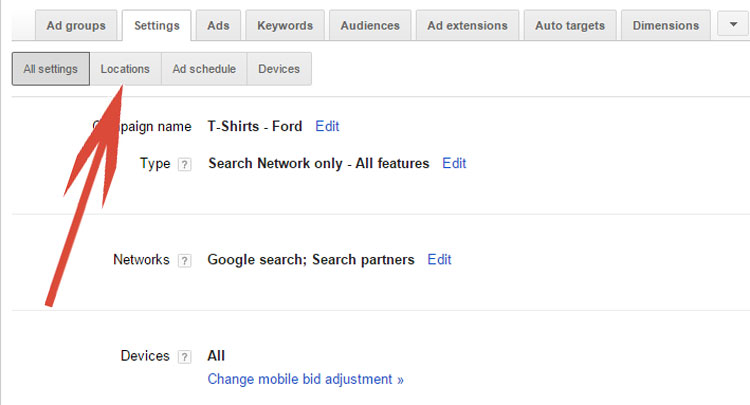 Within the Locations subtab, advertisers can view location information on their Campaign based on where ads are being served or where users being displayed ads are located. Advertisers can segment data, filter data, customize columns, change bids, download reports and view change history.
Within the Locations subtab, advertisers can view location information on their Campaign based on where ads are being served or where users being displayed ads are located. Advertisers can segment data, filter data, customize columns, change bids, download reports and view change history.
In order to view meaningful location data, advertisers will need to access the location report for either “What triggered the ad (geographic)” or “Where your users were (user location).”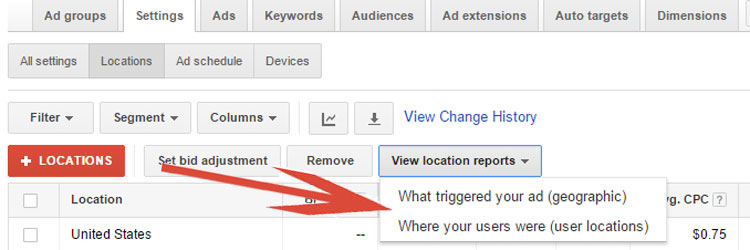 Once displaying a location report, advertisers can subdivide data based on State, Nielsen DMA region, Congressional district, County, Municipality, City, Postal code, Airport, Borough, Neighborhood or University.
Once displaying a location report, advertisers can subdivide data based on State, Nielsen DMA region, Congressional district, County, Municipality, City, Postal code, Airport, Borough, Neighborhood or University.
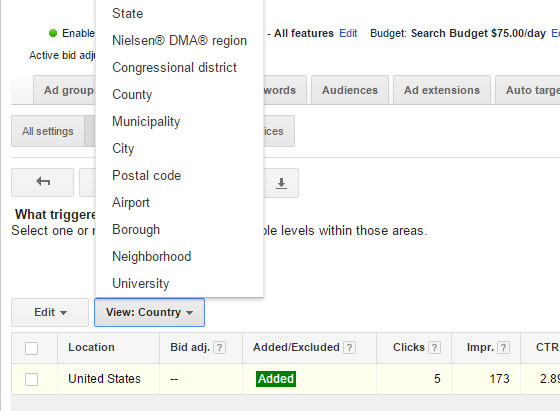
By subdividing data, advertisers gain insights into what areas within their geographic target are producing sales and can optimize their Campaign accordingly by increasing bids where conversions are occurring and decreasing bids where conversions are not.
Remember like with all bid adjustments, location bid adjustments are done in terms of percentage. For example, increasing a keyword bid by 30% would change a bid to $1.30, if the normal bid on a keyword was $1.00. Review Chapter 11, Strategies for Determining Bids in Google AdWords, for detailed information and best practices when determining keyword bids.
Summary
Whether a professional services advertiser or an e-commerce advertiser, proper location settings are essential in the profitability of a Google AdWords account. Ads should not be displayed to customers who are unable to use a product or service due to geographical restrictions. Showing ads to non-relevant customers is a waste of marketing budget that will many times substantially lower an account’s return on investment.
Google location tools allow an advertiser to serve ads to potential traffic at a broad or a granular level. In addition, through use of location reporting, advertisers can optimize bids based on historical results. Proper location settings are critical factors in all Campaigns and should not be ignored as incurring costs by displaying ads to users geographically unable to purchase a product or service could quite possibly be the fastest and is definitely the most wasteful way to explode a marketing budget.
Still need help or looking for someone to bounce ideas off? I am currently offering free marketing discovery sessions to those interested. Call True Online Presence at 1-888-456-6943 or schedule online.
ABOUT THE AUTHOR:
Andy Splichal is an online marketing strategist with more than a decade and a half of experience helping companies increase their online presence and profitable revenues. Although this blog focuses on driving profitable traffic through Google AdWords, True Online Presence offers additional services for lead generation as well as other proven marketing strategies customized for each client.

